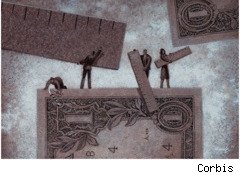 When actively managed exchange-traded funds emerged two years ago, many thought they were destined to become wildly popular. “They were billed as the ‘Holy Grail’ of ETF evolution by many,” says Christian Magoon, CEO of Magoon Capital. “The promise of coupling the efficiency, transparency and flexibility of the ETF structure with skilled active managers seemed like a blockbuster combination.”
When actively managed exchange-traded funds emerged two years ago, many thought they were destined to become wildly popular. “They were billed as the ‘Holy Grail’ of ETF evolution by many,” says Christian Magoon, CEO of Magoon Capital. “The promise of coupling the efficiency, transparency and flexibility of the ETF structure with skilled active managers seemed like a blockbuster combination.”
But despite the fanfare, active ETFs haven’t taken off. The combined assets of the 30 ETFs considered to be actively managed total only $2.4 billion, a tiny piece of an ETF market that totaled $790 billion last year.
It’s not that they have performed badly. In fact, from January through mid-November, active ETFs showed a 5.95% return, compared to 5.90% for passive ETFs, according to Morningstar (MORN).
Challenges for Newbies
So what’s the deal? Well, plenty of different factors are in play.
For one thing, actively managed ETFs have to be more transparent than their mutual fund counterparts. The Securities and Exchange Commission requires every ETF to disclose its holdings each day, with only a one-day lag. Mutual funds have to disclose their positions only once per quarter.
“Most fund managers do not want to disclose what positions they are holding or even considering buying as to not alert other managers of their investment strategy or potential portfolio,” says Cameron Short, senior vice president of Stifel Nicolaus. Simply put, adds Magoon: “Money managers want to hide their secret sauce.”
Then too, active ETFs are so new that they don’t have enough of a track record to convince investors to invest. They need to reach three years of age before they can get a Morningstar rating, for example.
“Typically, it takes three to five years of performance before sophisticated investors can get comfortable with a new product,” says David Marani an account executive with Drum Associates.
Consider the Disadvantages, Too
Also because active ETFs are relatively new, many investors don’t know much about them and their advantages, such as intraday trading. Unlike mutual funds, ETFs can be bought and sold at any time during the trading day. Plus, the active variety has higher tax efficiency.
“They are relatively new, and they’re a different type of ETF than investors might be used to,” says Tom Lydon, editor, ETF Trends, and author . And while traditional, passive ETFs give investors new ways to make hard-to-place bets, active ETFs directly compete with mutual funds, Marani says.
Investors also need to consider some disadvantages. For instance, while active ETFs are more transparent than mutual funds, they can be less transparent than traditional passive ETFs, and they often charge higher fees than traditional ETFs to pay that active manager behind the scenes.
Future Still Bright?
Figuring all of this out can be confusing, even for professional investors.
“As a professional, I have sometimes even had trouble trying to distinguish how close the pricing is on some of the actively traded ETFs, says Eric Dunavant, a certified financial planner and president of Dunavant Wealth Group. “At the end of the day, I think the traditional mutual fund market is better-suited to the long-term investor. A longer-term investor is less concerned with liquidity and more concerned with being able to understand what they own.”
So, for now, the jury is still out. “It’s too early to call active ETFs a success or a failure,” Lydon says.
adsonar_placementId=1505951;adsonar_pid=1990767;adsonar_ps=-1;adsonar_zw=242;adsonar_zh=252;adsonar_jv=’ads.tw.adsonar.com’;
After all, many of the big names — including JP Morgan Chase (JPM), TDAmeritrade (AMTD), Hartford (HIG) and so on — that have filed to launch their own ETFs are still waiting in the pipeline, he points out. “If these big names can get their funds to market, the hope is that they’ll in effect add a stamp of approval to active ETFs and, thus, bring in more assets from the skeptics who are currently holding out,” he adds.
Magoon predicts that active ETFs will do well. They’re “beginning to show some of the potential that early advocates forecasted,” he says. “As their structure evolves, track records emerge and star managers launch products, the future will only grow brighter for active ETFs.”
Get info on stocks mentioned in this article:
AMTD
HIG
JPM
MORN
Manage Your Portfolio


Leave a Reply